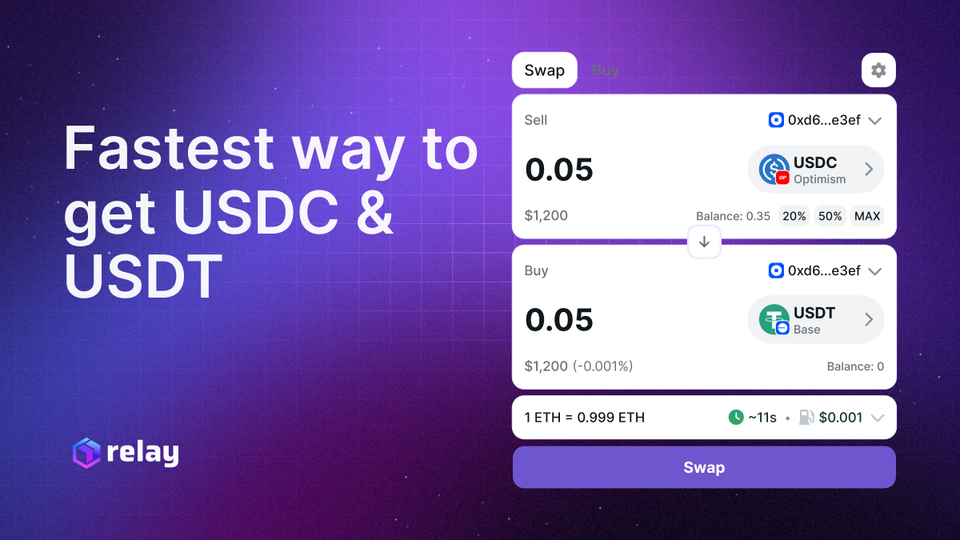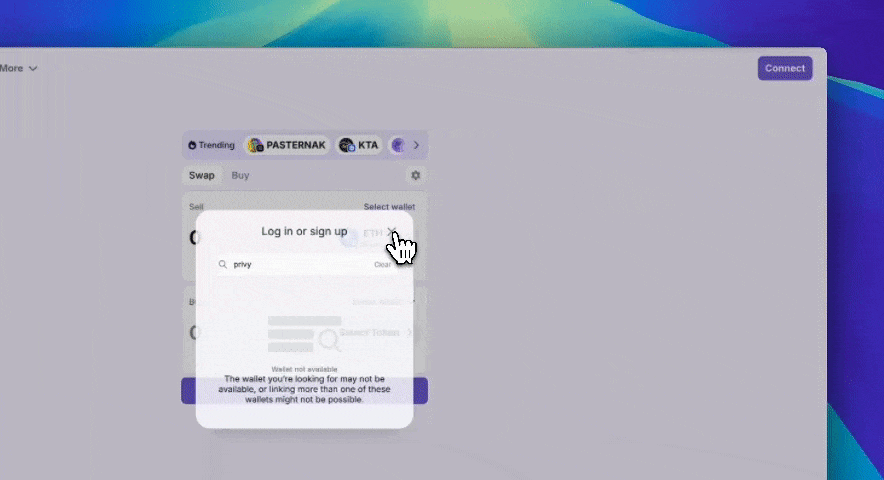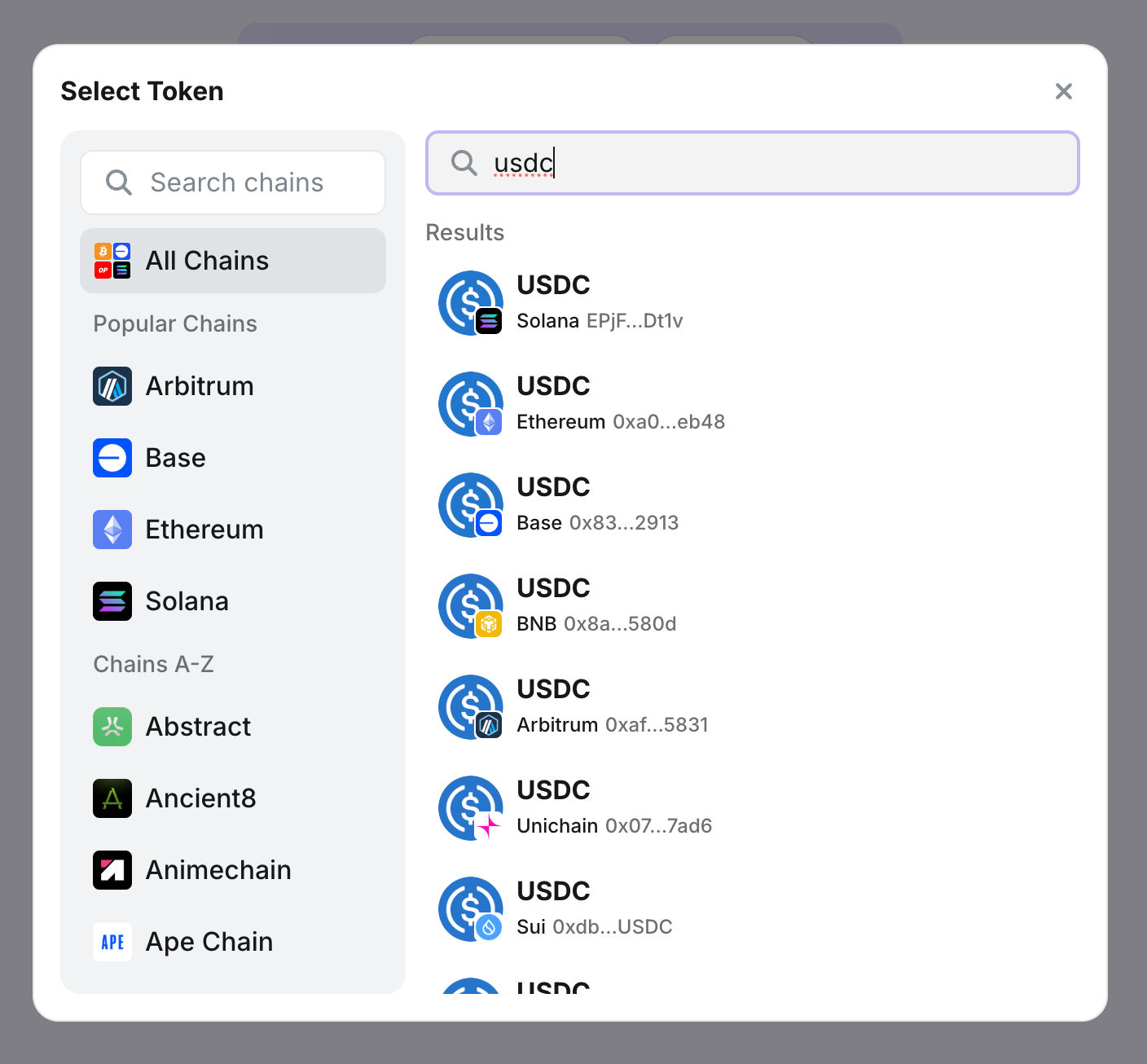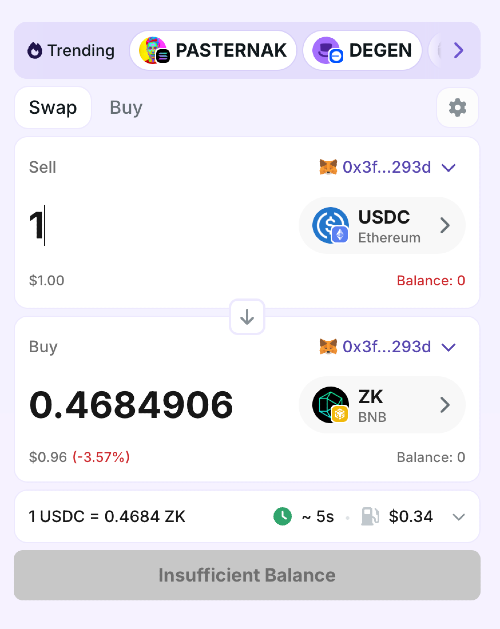How to Get from USDT or USDC to Any Token

Picture this: You hold stablecoins like USDT or USDC and want to invest in a new crypto token or rare NFT not listed on major exchanges. These lesser-known assets are termed “longtail assets,” representing the vast array of digital assets beyond the top coins. Previously, converting stablecoins to obscure tokens was complicated, requiring several exchanges and transfers. Now, the process is significantly simpler.
In this post, we’ll explain how you can use Relay’s cross-chain swaps to jump from stablecoins like USDT or USDC to any longtail asset quickly, cheaply, and securely.
Understanding Longtail Crypto Assets
The term longtail assets refers to the multitude of lesser-known crypto tokens and digital collectibles that exist beyond the top few cryptocurrencies. While everyone knows Bitcoin and Ethereum, there are tens of thousands of smaller-cap coins, utility tokens, and NFTs out there. These include things like:
- Emerging DeFi or GameFi tokens – New project tokens that aren’t yet on mainstream exchanges.
- Governance and utility tokens – Coins used within specific DApps or blockchain ecosystems.
- Meme coins and community tokens – Trendy coins that can explode in popularity overnight but remain “off the radar” of large exchanges.
- NFTs and digital collectibles – Unique assets like digital art or in-game items on various blockchains.
For retail crypto users, these longtail assets represent exciting opportunities – the next big thing might be hiding among them. Institutional investors might also seek exposure to niche assets for diversification. Developers may need these tokens for testing or integrating with new protocols. The challenge is, how do you actually swap your stablecoins for these longtail assets easily?
The Challenge: Swapping USDT or USDC to Emerging Tokens
Stablecoins like USDT (Tether) and USDC (USD Coin) are the common “cash” of the crypto world. They’re widely used as a stepping stone to buy other cryptocurrencies. (USDT alone had a market cap of over $114 billion by mid-2024 and about 70% of the stablecoin market share, underscoring how popular stablecoins are for trading.) If you’re holding value in USDT or USDC, it’s convenient – until you want to purchase a smaller token that isn’t readily accessible.
What makes it tricky to buy longtail assets? A few hurdles:
- Limited Exchange Listings: Many new tokens aren't on major exchanges, so you can't swap USDT for them on Coinbase or Binance.
- Different Blockchains: Your USDC might be on Ethereum, but the token you want could live on another network (Solana, BNB Chain, Polygon, Avalanche, etc.). Blockchains are siloed from each other, so a direct transfer isn’t possible without a bridge.
- Complex Process: Traditionally, you might have to send your USDT to an exchange that supports the target asset (if one exists), trade for it, then withdraw it to the target blockchain. Or, you’d manually use a cross-chain bridge to move USDT to the other chain, then do a swap on a decentralized exchange (DEX) for the new token. That’s multiple transactions, multiple fees, and multiple points of failure.
- Technical Know-How: Using bridges and DEXs can be confusing if you’re not very technical. One wrong move (wrong address, wrong network) and funds can be lost.
Relay Makes Cross-Chain Swaps Easy
This is where Relay comes in to save the day. Relay is a cross-chain swap platform that essentially handles all the heavy lifting for you. It allows you to swap one asset on a certain blockchain for another asset on a different blockchain in a single, simple transaction. In other words, you can go straight from your stablecoin to the longtail asset without manually bridging or using multiple exchanges.
How does Relay work? You don’t need to get too technical to appreciate it. From a user’s perspective, you just tell Relay what you have and what you want. For example: “I have USDC on Ethereum, and I want to buy Token XYZ on Avalanche.” Relay will automatically find a route to perform this swap – maybe it will bridge your USDC to Avalanche and then trade for XYZ on a DEX – but you don’t have to worry about the details. You just confirm the swap, and Relay delivers the XYZ tokens to your wallet on Avalanche. It’s like magic, but powered by smart cross-chain technology!
Why use Relay for these swaps? Here are some big benefits:
- 🚀 Speed: Cross-chain transactions can be slow if you do them manually, but Relay is optimized for fast execution. It will use efficient routes so you get your new asset as quickly as possible. No more waiting hours for a bridge to confirm then another trade to finalize.
- 💰 Low Cost: By aggregating steps, Relay often reduces the overall fees. You avoid multiple sets of gas fees or withdrawal fees. Relay’s smart routing finds a low-cost path (for instance, using a cheaper network to bridge if possible) so swapping USDT to a longtail token won’t cost an arm and a leg.
- 🔒 Security: Security is a huge concern with cross-chain transfers – nearly 69% of crypto hacks in 2022 were due to bridge vulnerabilities. Relay’s solution is built with security in mind, leveraging well-audited smart contracts and safe bridging protocols to protect your funds. You stay in control of your crypto (Relay is non-custodial, meaning you hold your keys), and the process is designed to minimize risk at each step. In short, you can swap with peace of mind.
- 🌐 Cross-Chain Flexibility: Relay supports a wide range of blockchains and tokens. Whether your target asset is on Ethereum, Binance Smart Chain, Polygon, Arbitrum, Avalanche, or another network, Relay likely has you covered. This broad support lets you explore opportunities on many ecosystems without juggling a dozen different wallets or exchanges.
- 👍 Ease of Use: Perhaps most importantly, Relay makes the user experience simple. Its interface is user-friendly – even if you’re not a developer or DeFi expert, you can follow the prompts to execute a swap. It feels as straightforward as a normal crypto trade, despite a lot of complex stuff happening in the background. For a retail user, it’s like having a guided tunnel through the maze of cross-chain trading. Developers and power users also benefit by saving time on complex swap scripting, letting them focus on building or investing rather than babysitting transactions.
What Longtail Assets Can You Access with Relay?
Using a cross-chain swap solution like Relay allows access to a wide range of assets. Any token on a supported blockchain can be swapped from your USDT or USDC, creating numerous opportunities. For instance:

- Brand-New Altcoins: When a new altcoin launches on, say, a Layer-2 network or an alternative Layer-1, you can be among the first to get it. No need to wait for a big exchange listing – swap your stablecoin for it via Relay.
- DeFi and Governance Tokens: Interested in a DeFi platform’s governance token that only trades on a specific DEX? Convert USDC to that token in one step. Now you can participate in that platform’s ecosystem or governance.
- Gaming and Metaverse Tokens: Many blockchain games or metaverse projects have their own currencies on specialized chains. With Relay, you can jump into these economies easily – e.g. swap USDT for a game token on another chain to start playing or investing.
- Regional or Niche Stablecoins: Perhaps you want to move into a different stablecoin or asset that’s native to another chain (for yield farming or arbitrage). Relay can swap your USDT into those as well, cross-chain.
- NFT Purchases: Even NFTs benefit – while you can’t “swap” a fungible token directly for an NFT in one go, Relay can help you get the cryptocurrency you need to buy that NFT. For instance, if you want to buy an NFT on Solana but only have USDC on Ethereum, you can swap Ethereum USDC to Solana’s SOL token (or Solana USDC) using Relay, then use that to purchase the NFT. It simplifies transferring funds to the correct chain and currency.
Step-by-Step: How to Swap USDT/USDC for a Longtail Asset Using Relay
So, how exactly do you make a swap from stablecoin to longtail asset on Relay? It’s pleasantly simple. To use Relay, follow these steps:

Connect Your Wallet: Go to Relay’s website and link your crypto wallet (like MetaMask) that holds USDT or USDC. Relay is non-custodial, so you maintain control of your funds.

Select Your Stablecoin and Network: Choose your stablecoin (USDT or USDC) and its network (Ethereum, Polygon, etc.).
Pick Your Desired Asset: Select the asset you want to acquire, whether it's a token or an NFT. Specify the target network, such as “XYZ Token on Avalanche” or “SOL on Solana”.

Check the Route and Fees: Relay will find the best swap route and display the expected outcome and fees. For example, it might show “Swapping 100 USDC (Ethereum) → ~99.8 XYZ (Avalanche)”. Ensure all details are accurate.
Swap and Confirm: Hit the swap button and confirm the transaction in your wallet. Relay will then execute the cross-chain swap. This may involve locking your USDC in a bridge and swapping on a DEX behind the scenes, but it’s all automated.
Receive Your Longtail Asset: After a short processing time, you’ll receive the target asset in your wallet on the destination chain. Ta-da! You just went from USDC to that hard-to-get token without the usual hassle. Enjoy your new asset, whether it's a coin or an NFT.
Throughout this process, you never had to set up an account on a new exchange, nor juggle multiple transactions manually. Relay handled it in one go, saving you time and potential error.
